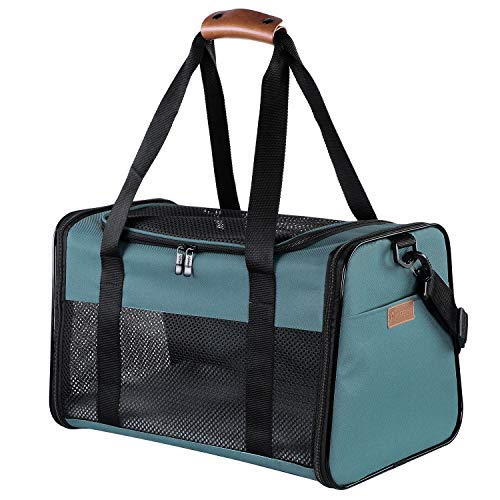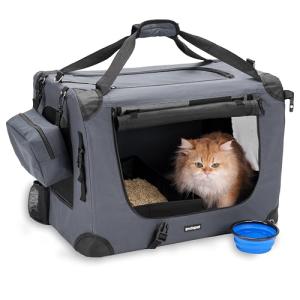The plaintive meow at the door, the yearning gaze out the window – every cat owner, at some point, has felt the pull of the 'indoors vs. outdoors' debate. It's a question as old as pet ownership itself, and one that continues to spark fervent discussions among feline aficionados. Is it kinder to allow our feline companions to roam free, experiencing the world in all its untamed glory? Or is it more responsible to keep them safely confined within the walls of our homes, shielded from the myriad dangers that lurk beyond? This is not a simple question, nor is there a universally "right" answer. It's a complex issue fraught with passionate opinions and genuine concerns for our beloved pets. This article aims to navigate this often-contentious territory, stepping away from anecdotal evidence and emotional pronouncements to objectively explore the arguments from both sides. We will delve into the pros and cons of allowing cats to roam freely versus keeping them exclusively indoors, providing a balanced perspective designed to empower you, the cat owner, to make an informed decision tailored to your individual circumstances and the unique needs of your feline friend. At the heart of this debate lies a fundamental dichotomy: the tension between a cat's innate "natural" desires and the imperative to ensure their safety and well-being in a world increasingly fraught with hazards for domestic animals.
The allure of the outdoors for a cat is undeniable. It speaks to their very nature, to the deep-seated instincts honed over millennia of evolution. Allowing a cat to roam free is, for many, seen as providing them with the opportunity to live a more "natural" and fulfilling life. Chief among these natural drives is the powerful hunting instinct. Cats are, by nature, predators, even if the most strenuous hunt in your house involves stalking a rogue dust bunny. The outdoors provides an arena where these instincts can be genuinely expressed. The rustle of leaves, the scurrying of unseen creatures in the undergrowth, the fluttering of birds – these are all stimuli that trigger their predatory behavior, allowing them to stalk, chase, and pounce. This isn't just about securing a meal; it's about engaging in a deeply ingrained behavior that provides both mental and physical stimulation. The focus and concentration required for hunting, even play hunting, is mentally enriching, while the physical exertion involved in stalking and chasing contributes to their physical fitness.
Beyond hunting, the outdoors satisfies a cat's innate desire for exploration and territoriality. Cats are inherently curious creatures, and the world outside offers a constantly changing landscape of sights, sounds, smells, and textures. Roaming allows them to establish and patrol a territory, a fundamental feline behavior. This territory isn't just a physical space; it's a complex sensory map, marked with scent and patrolled with vigilance. This act of territorial marking and exploration is crucial for their sense of security and well-being. Confining them indoors can, for some cats, feel like a sensory deprivation chamber compared to the richness of the outside world. The increased opportunity for exercise and physical activity is another significant advantage of outdoor access. Roaming, climbing trees, jumping fences, and engaging in active hunting pursuits all contribute to a cat's physical fitness in ways that the often-limited space of an indoor environment simply cannot replicate. Outdoor cats are naturally more active, and this increased physical activity is essential in combating obesity, a significant health concern for indoor cats, and maintaining overall physical health and vitality. Finally, the sheer novelty and constant change of the outdoor world provide unparalleled mental stimulation and enrichment. The ever-shifting patterns of light and shadow, the symphony of natural sounds, the myriad of scents carried on the breeze – these all contribute to a rich sensory experience that keeps a cat mentally engaged and alert. This constant novelty can be crucial in preventing boredom and promoting cognitive health, ensuring a more stimulated and content feline companion.
However, the idyllic image of a cat freely roaming through sun-dappled gardens and verdant meadows often obscures the darker side of outdoor life, the shadow of danger that persistently looms over free-roaming felines. Perhaps the most significant threat to outdoor cats is traffic and vehicle accidents. Statistics sadly and consistently highlight traffic as a leading cause of injury and premature death for cats allowed outdoors. The unpredictable nature of traffic poses a constant and often unavoidable risk. Cats, despite their agility and reflexes, can be easily startled by loud noises or sudden movements, misjudging the speed of approaching vehicles or darting into the road without warning. This danger is, of course, exponentially amplified in urban and suburban environments, where roads and vehicles are ubiquitous. Even seemingly quiet residential streets can quickly transform into deadly thoroughfares.
Beyond the ever-present threat of vehicles, outdoor cats face the very real danger of predators. While domestic cats are predators themselves, they can also become prey, particularly to larger animals. Coyotes and foxes, increasingly common even in suburban areas, pose a significant threat, especially to smaller cats or vulnerable kittens. Large dogs, even those not intentionally aggressive, can inflict serious injury or death on a cat during a territorial dispute or chase. In certain geographic locations, birds of prey, such as hawks and owls, can also pose a predatory threat, especially to smaller cats or kittens left unattended. Even amongst their own species, the outdoor world is often a battleground. Territorial disputes and fights with other cats are commonplace for outdoor felines. These encounters, while sometimes seemingly minor skirmishes, can lead to serious injuries, from lacerations and abscesses to deep puncture wounds. Moreover, these fights are a major route of transmission for serious feline diseases, such as Feline Immunodeficiency Virus (FIV) and Feline Leukemia Virus (FeLV), debilitating and often fatal illnesses.
The outdoor environment is also a breeding ground for disease and parasites. Infectious diseases, beyond FIV and FeLV, abound in the outdoor world, readily spread through contact with other animals, both feline and otherwise. Rabies, while less common in domestic cats due to vaccination efforts, remains a serious concern. Upper respiratory infections, highly contagious among cats, are easily transmitted in outdoor cat populations. Parasites, both external and internal, are a constant and often unpleasant reality for outdoor cats. Fleas and ticks, ubiquitous in outdoor environments, can cause skin irritation, transmit diseases, and in severe infestations, lead to anemia. Mites, causing mange and ear mites, are readily picked up outdoors. Internal parasites, such as worms (roundworms, hookworms, tapeworms) and protozoa (like Giardia and Coccidia), are easily ingested from contaminated soil, water, or prey, leading to a range of health problems, from digestive issues to more severe systemic illnesses. The cost of parasite prevention and treatment for outdoor cats can be substantial, both financially and in terms of the cat's health and discomfort.
The dangers of the outdoor world extend beyond the biological and into the chemical and physical realms. Toxins and environmental hazards are unfortunately prevalent in our modern landscapes. Pesticides and herbicides, routinely used on lawns and gardens, can be ingested by cats directly, through grooming their paws after walking on treated areas, or indirectly, by consuming prey that has been exposed. Rodenticides, used to control rodent populations, pose a particularly grave threat, as cats, being natural predators of rodents, are highly susceptible to secondary poisoning if they ingest poisoned prey. Poisonous plants, both cultivated garden varieties and wild plants, are another hidden danger. Many common plants, from lilies and tulips to azaleas and oleander, are toxic to cats if ingested, leading to a range of symptoms from mild gastrointestinal upset to severe organ damage and death. Antifreeze, with its deceptively sweet taste, is notoriously and tragically toxic to cats, even in minute quantities, causing rapid and fatal kidney failure. Other common household and garage chemicals, if left accessible outdoors, can also pose significant poisoning risks.
Beyond the physical and biological threats, outdoor cats face the risk of simply getting lost or being stolen. Territorial disputes, particularly for unneutered cats, can lead them further and further from home as they chase or flee from rivals, becoming disoriented and unable to find their way back. Being chased by predators or harassed by aggressive dogs can similarly send a cat fleeing into unfamiliar territory, increasing the risk of getting lost. While less frequent, the heartbreaking reality of cat theft or misidentification also exists. A friendly, well-groomed cat roaming freely may be mistaken for a stray or simply be stolen by someone with less than honorable intentions, leaving distraught owners with little hope of reunion.
Finally, and increasingly considered within the ethical considerations of pet ownership, is the impact of free-roaming cats on wildlife. Domestic cats, despite being beloved pets, are highly effective predators, and their impact on native wildlife populations, particularly birds and small mammals, is well-documented and often devastating. While individual cats may vary in their hunting prowess, the sheer number of domestic cats, particularly in urban and suburban areas, collectively exerts a significant predation pressure on local ecosystems. This predation can contribute to declines in native bird populations, small mammals, reptiles, and amphibians, potentially disrupting local ecological balance and, in sensitive ecosystems, even contributing to local extinctions. Responsible pet ownership, for many, now includes acknowledging and minimizing our pet's impact on the natural world, and this is a crucial element of the indoor vs. outdoor debate.
In stark contrast to the perilous freedom of the outdoors, the sanctuary of home offers a haven of safety and longevity for our feline companions. Keeping cats indoors fundamentally eliminates or drastically reduces the vast majority of the dangers inherent in outdoor life. Traffic accidents, predator attacks, exposure to toxins, and fights with other animals – these risks are virtually nonexistent within the controlled environment of a home. Statistically, indoor cats live significantly longer lives than their outdoor counterparts, a testament to the protective nature of an indoor lifestyle. Free from the constant threats of the outside world, indoor cats are less prone to injuries and trauma, leading to a healthier and more comfortable life.
The controlled environment of an indoor home also offers unparalleled disease and parasite prevention. Minimized exposure to other animals directly translates to minimized exposure to infectious diseases. The risk of contracting FIV, FeLV, rabies, or other contagious illnesses is dramatically reduced when cats are kept indoors and contact with unknown animals is limited. Similarly, indoor cats are significantly less likely to acquire fleas, ticks, mites, and worms. This makes parasite control simpler, less costly, and less stressful for both cat and owner. Maintaining a clean and healthy environment is also far easier indoors, reducing exposure to environmental allergens and pathogens that can trigger respiratory issues or other health problems. Beyond the direct benefits to the cat's health, keeping cats indoors also offers a significant benefit to the wider environment. Indoor cats, by definition, do not prey on native wildlife, eliminating their contribution to the ecological impact of domestic cat predation and fulfilling an increasingly recognized aspect of responsible pet ownership.
Moreover, indoor cats are often easier to monitor for health concerns and receive consistent veterinary care. Living in close proximity, owners are more likely to notice subtle changes in behavior or health that might indicate an underlying medical issue, allowing for earlier detection and intervention. Administering medications, preventative treatments, and ensuring regular health checks are also considerably easier with cats who are always accessible and safely within the home.
However, the very qualities that make indoor life safe can also contribute to its potential downsides. Confinement, while protective, can also lead to boredom and a lack of enrichment if not actively addressed. The indoor environment, while secure, can become monotonous and lack the sensory variety and constant stimulation of the outdoors if not intentionally enriched. This sensory deprivation can lead to boredom, frustration, and the development of behavioral problems. Destructive scratching, excessive meowing, inappropriate elimination, and even aggression can all be manifestations of boredom and unmet needs in indoor cats lacking sufficient stimulation. It is crucial to emphasize that indoor cats need intentional enrichment to thrive, to compensate for the lack of natural stimulation they would otherwise experience outdoors.
Reduced physical activity is another potential consequence of an indoor lifestyle. Indoor environments, particularly smaller apartments or houses without dedicated play spaces, may offer limited opportunities for spontaneous exercise, potentially leading to weight gain and obesity. Obesity, in turn, is a major risk factor for a cascade of health problems in cats, including diabetes, arthritis, heart disease, and liver disease. Providing adequate exercise and play opportunities for indoor cats is not just about preventing boredom; it's about actively promoting their physical health and well-being.
Furthermore, while indoor life protects cats from many dangers, it can also suppress certain natural behaviors if owners are not proactive in providing suitable indoor outlets. Hunting instincts, while perhaps less crucial for survival in a domestic setting, remain deeply ingrained. If not provided with appropriate outlets for these instincts, such as interactive play with toys that mimic prey, cats may become frustrated or develop undesirable behaviors. Similarly, the innate feline drive to explore and mark territory needs to be acknowledged and addressed within the indoor environment. Providing vertical space, scratching posts, and opportunities for exploration within the home can help satisfy these territorial needs in a safe and appropriate manner. Finally, some cats, particularly those previously accustomed to outdoor access, may experience stress and frustration if suddenly confined indoors without adequate transition and enrichment. A gradual transition to indoor living, combined with a concerted effort to provide ample enrichment and address their behavioral needs, is crucial to minimize stress and ensure a smooth and positive adjustment to an indoor-only lifestyle.
The decision of whether to let your cat roam free or keep them indoors is deeply personal and should be carefully considered based on a multitude of factors unique to your individual situation. Location and environment play a significant role. Urban and suburban areas, with their high traffic density and busy roads, present a significantly higher risk of vehicle accidents compared to more rural settings. Consider the traffic density and speed in your immediate vicinity. Even seemingly quiet residential streets can be surprisingly dangerous. Assess the local presence of predators. Are coyotes, foxes, or large dogs common in your neighborhood? Acknowledge the density of the local cat population outdoors. High cat density can increase the risk of fights and the spread of infectious diseases.
Your cat's individual personality and temperament are also crucial considerations. Highly active and energetic cats might seem to "need" the space and stimulation of the outdoors, but this energy can often be successfully channeled and managed with appropriate indoor enrichment. Consider your cat's fearfulness or boldness. A fearful or skittish cat might be overwhelmed and stressed by the outdoor environment, while a particularly bold and adventurous cat might be more prone to taking risks and getting into trouble. If your cat has previous outdoor experience, transitioning them to an indoor-only lifestyle might present unique challenges and require a more gradual and patient approach.
Your own lifestyle and ability to provide enrichment are equally important factors. Indoor cats are reliant on their owners for stimulation and entertainment. Are you able to commit the time and energy necessary to provide regular play sessions, interactive enrichment, and environmental enrichment for an indoor cat? Consider your financial resources for veterinary care. Both indoor and outdoor cats require veterinary care, but outdoor cats may statistically incur higher medical expenses due to injuries, illnesses, and parasite infestations. However, indoor cats also require financial investment in toys, climbing structures, scratching posts, and other enrichment items to thrive. Finally, be aware of local laws and regulations pertaining to pet ownership. Some areas have leash laws or restrictions on allowing pets to roam freely, and violating these ordinances can lead to fines or legal repercussions. Consider the prevailing community attitudes towards outdoor cats in your neighborhood. Are there concerns about cats in gardens or wildlife? Being mindful of community norms can help prevent potential conflicts with neighbors.
For those who yearn to offer their cats some taste of the outdoors while mitigating the inherent risks of free roaming, there are safe and increasingly popular compromise options. Supervised outdoor time, under your direct control, can provide a stimulating and enriching experience while ensuring safety. Leash training and harness walking, while requiring patience and training, can allow your cat to explore the outdoors under your watchful eye. Creating enclosed yards or "cat-proofed" gardens, using specialized fencing and netting, provides a secure outdoor space where cats can roam freely without the risk of escaping into uncontrolled environments. "Catios," enclosed outdoor patios or window boxes specifically designed for cats, offer a safe and contained way for cats to enjoy fresh air, sunshine, and outdoor sights and sounds without the dangers of roaming free.
Regardless of whether you choose to keep your cat exclusively indoors or explore safe outdoor options, maximizing indoor enrichment is paramount for the well-being of any feline companion. Vertical space is key. Cat trees, shelves, and window perches allow cats to climb, explore, and establish territory within the home, mimicking the vertical dimension of their natural environment. Interactive toys and puzzle feeders are essential for stimulating their hunting instincts and providing mental challenges. Regular, dedicated play sessions are crucial for providing exercise, mental stimulation, and strengthening the bond between you and your cat. Provide a variety of scratching posts and surfaces, in different materials and orientations, to satisfy their natural scratching behavior and protect your furniture. Window views, ideally overlooking bird feeders (placed safely out of reach of cats to prevent bird predation from windows), offer hours of visual stimulation and entertainment. Finally, scent enrichment, using catnip, silver vine, or other feline-attracting scents, can engage their sense of smell and provide additional sensory stimulation.
Ultimately, there is no universally "right" or "wrong" answer to the question of whether to let your cat roam free or keep them indoors. The best choice is profoundly individual and depends on a careful and honest assessment of the risks, benefits, and the unique circumstances of your cat, your environment, and your lifestyle. Weigh the allure of natural instincts against the shadow of dangers. Consider the benefits of indoor safety versus the potential for indoor boredom. The goal is to prioritize your cat's overall welfare, to ensure their safety, health, and well-being while respecting their natural instincts and needs as much as possible within the confines of a domestic setting. Make an informed decision, based on careful consideration and a commitment to responsible pet ownership, choosing the option that you believe best balances safety and quality of life for your cherished feline companion. Remember, both indoor and outdoor lifestyles, when managed responsibly and thoughtfully, can lead to happy, healthy, and fulfilling lives for our beloved cats.







